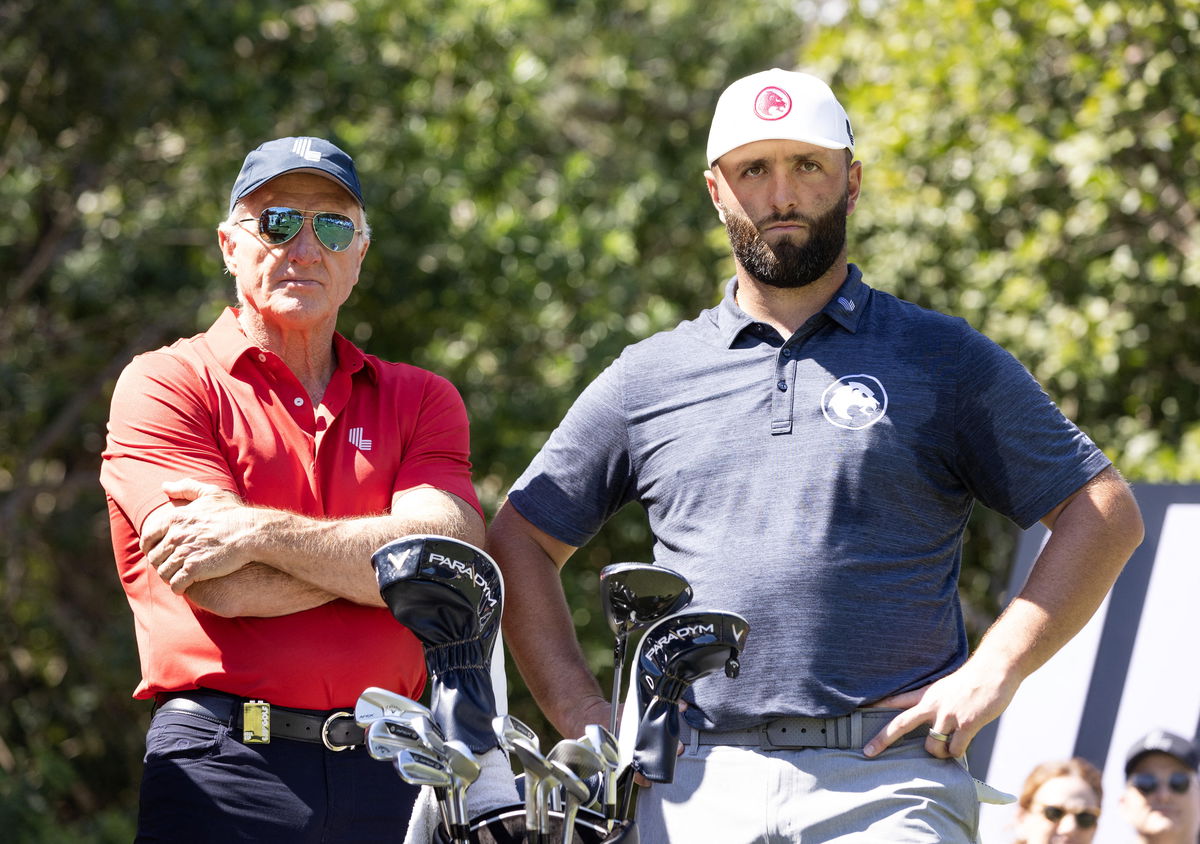
USA Today via Reuters
Feb 2, 2024; Playa del Carmen, Quintana Roo, MEX; Jon Rahm of Team Legion XIII, right, stands with LIV CEO Greg Norman on the first tee during the fist round of the LIV Golf Mayakoba tournament at El Chamaleon Golf Course. Mandatory Credit: Erich Schlegel-USA TODAY Sports

USA Today via Reuters
Feb 2, 2024; Playa del Carmen, Quintana Roo, MEX; Jon Rahm of Team Legion XIII, right, stands with LIV CEO Greg Norman on the first tee during the fist round of the LIV Golf Mayakoba tournament at El Chamaleon Golf Course. Mandatory Credit: Erich Schlegel-USA TODAY Sports
LIV Golf lacks no resources. Both literally and metaphorically. PIF, the Saudi Sovereign Fund, that backs the rival league, has deep pockets reaching up to $700 billion. They have, for the better part, used their resources quite well, although not quite judiciously, in poaching players from the PGA Tour.
Watch What’s Trending Now!
Yet, as a testament to spectacular irony, the firepower on the course hasn’t translated into the viewership or the fanbase. Neither has its TV ratings over the years. The inaugural event continues to make a splash, throwing embers of hope before slowly petering out. The situation in its third season is no different because LIV hasn’t done anything significantly different in the last three years.
Top Stories
LIV Golf Braces for Another Possible Exit in Wake of Brooks Koepka Departure

Rory McIlroy Makes Feelings Clear on Bryson DeChambeau’s PGA Tour Return: ‘Have Lost…’

Amanda Balionis Confirms New Relationship Ending Months of Rumors

Bryson DeChambeau Gives Reality Check to Phil Mickelson When Asked to Select His Mount Rushmore for Golf

After Brooks Koepka, Another Pro Cuts All Ties With LIV Golf & Publicly Backs PGA Tour

ADVERTISEMENT
The format still needs some convincing
LIV Golf Mayakoba had defending Masters Champion Jon Rahm teeing off at the breakaway side for the first time. On top of that, the upstart league got, arguably, one of its best final rounds. Joaquin Niemann and Sergio Garcia fought tooth and nail till the end in fading daylight.
ADVERTISEMENT
Here was a man, a youngster, who, despite his stellar run of form in the last few months, was vying for a spot in the Majors, which he was denied courtesy of joining the league where he is playing now. The Chilean international, once a rising star on the tour, also shot his first sub-60 round in the first round.
ADVERTISEMENT
On the other side was a veteran, arguably past his prime, going toe to toe with a player nineteen years younger than him. LIV Golf didn’t lack any storylines. It never does, in fact. In the final round of the Las Vegas event, they paired Jon Rahm, Bryson DeChambeau, and Dustin Johnson in the marquee group.
Despite that, the final round in Las Vegas garnered only 297,000 viewers. That was 51st on all TV ratings that day. By comparison, Golf Central’s pre-round coverage drew around the same number of viewers. That was also down from the 432,000 views on LIV Golf Mayakoba.
The Mayakoba TV rating is also a case in point. The inaugural event, despite so many storylines, fell way short of the PGA Tour’s third-round re-run on CBS, which got around three times more views. The problem is that neither the shotgun start nor the teams have gotten any thumbs-up from the general audience. Very few fans are seemingly invested in Jon Rahm’s team yet. It’s the individual performance that gets highlighted at the end of the day.
ADVERTISEMENT
Pebble Beach PGA (Saturday), CBS: 1.951m
LIV Golf (Saturday), CW: 168K
LIV Golf (Sunday), CW: 432K https://t.co/I7csAFZ3vK— Sports TV Ratings (@SportsTVRatings) February 6, 2024
Unlike the Ryder Cup or college golf, the teams don’t have any connecting threads other than a potpourri of players vying for the top prize. The teams aren’t rooted in a culture, an ethos, or a locale. It’s perhaps surprising that every year, only the inaugural event gets more viewers, not the season-ending team championship with champagne showers and blaring DJs.
ADVERTISEMENT
Non-traditional viewing options for LIV golf
This offseason, LIV Golf should’ve been on the hunt for what it needed the most. Not Jon Rahm. Or Ludvig Aberg, Viktor Hovland, or Wyndham Clark, for that matter. They had enough star power for a league that was non-existent less than three years ago.
What they needed was far less costly but harder to get. A broadcasting partner that will telecast its Friday rounds. Greg Norman already secured his television partner for the Saturday and Sunday rounds on CW, the network that its own officials admitted was secondary, without any previous broadcasting experience.

Reuters
Golf – LIV Golf Mayakoba – El Camaleon Mayakoba Golf Course, Playa del Carmen, Mexico – February 4, 2024 Legion XIII’s Jon Rahm during the final round REUTERS/Raquel Cunha
Nevertheless, it was a futile exercise. Like the past two years, LIV Golf viewers have to switch between apps, YouTube, and TV for two days, much to the chagrin of many fans. Friday rounds are streamed only on the app, whereas the final two rounds are available on TV. The coverage on CW was not on par with the multi-channel coverage of the PGA Tour.
ADVERTISEMENT
Ironically, LIV Golf’s identity lies in a factor that hasn’t found any support from the traditional fanbase. Shotgun starts, still a little disorienting to traditional viewers, hasn’t found acceptance among fans.
ADVERTISEMENT
Is it a sustainable model for the LIV Golf bankroller?
The outlying question remains: given the way LIV Golf’s ratings have dwindled, is it sustainable in the long run? While PIF’s riches might provide a short-term benefit—the New York Times reported PIF invested around $2 billion in LIV Golf—ultimately, Yasir Al-Rumayyan means business. Make no mistake, Jay Monahan means that as well, which is why a deal with Strategic Sports Group became a necessity as LIV Golf was right for Tour’s business interests as well.
Nevertheless, for sports, more than live audiences, TV and streaming audiences matter for ad revenue and sponsorships. Unless LIV cracks the TV code anytime soon, the road to sponsorship revenue will still be a far cry. The PGA Tour, meanwhile, had a deal with ESPN, CBS, and NBC, three streaming and broadcasting giants well worth $700 million per year until 2030.
Read more: ‘Not Acceptable’: PGA Tour Pro Loses Temper at the OWGR Amid Massive ‘Majors’ Failure
ADVERTISEMENT
LIV Golf, on the other hand, generated virtually zero revenue in its inaugural session. The second season, with a deal with CW, was better, but only $100 million in total, around one-fifth of what they paid Rahm. Out of which, only $2–3 million came from a revenue-sharing agreement with CW. Unlike ESPN, NBC, or Warner Bros., CW doesn’t pay the Greg Norman-fronted side any money. Rather, they have a revenue-sharing agreement. That alone tells a lot about major broadcasters’ trust in LIV’s popularity among fans.
Watch This Story | LIV Golf News: 3 Major Takeaways as the $3B PGA Tour-PIF Merger Deadline Gets Extended, Per Reports
ADVERTISEMENT
ADVERTISEMENT
ADVERTISEMENT

